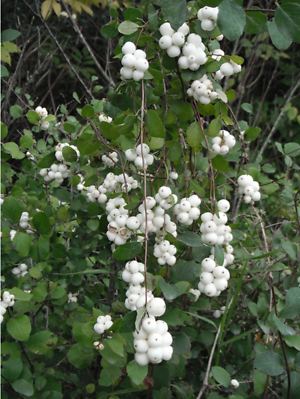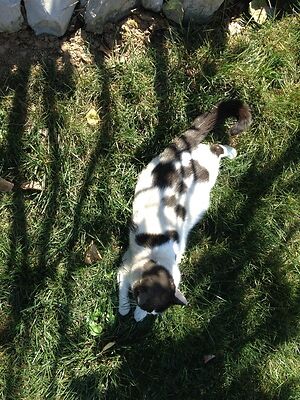Good morning. My name is Carol, which means song of joy and I’ll be talking to you today about the Snowberry plant. The Latin name for Snowberry is Symphoricarpos albus.

“Symphori” means bear together, and you can see how the snowberries hand together in a clump. “Carpos” means fruits, and “albus” means white, without luster. The berries are dull white, not shiny. The common name of this plant, Snowberry, also refers to the white fruits.
The plants bloom in the spring from mid-May to July with small white and pinkish flowers that attract hummingbirds, but these natives are mostly pollinated by bees.
When I did research for the Snowberry, I learned that the fruits of this plant are called drupes. I didn’t know that word, but it means that they have a fleshy fruit surrounding a large seed, like in a peach or a plum. Of course, Snowberry seeds aren’t that large because the berries are so small.
Symphoricarpos has about 15 different species, 12 of which are found in the United States, from southeast Alaska to southern California and all across the Northern U.S. and Canadian provinces. Snowberries usually grow 3-9 feet tall and are sometimes known as Waxberry, White Coralberry, or White, Thin-leaved, or Few-flowered Snowberry.
You might wonder why there is so much fruit on the plant still, so late in the fall. Well, I grew this plant at my house in Northern Illinois for about 15 years. I planted them because they are native and they would produce berries for the birds. And I can tell you that the berries last through most of the winter into spring. The reason for this is that they have kind of a bitter taste, so it’s not the favorite berry for some of the animals that feed on it.
But the good thing is that the berries stay on the plant into spring so there is food all through the winter for the animals.
Common Snowberry has long been grown as an ornamental shrub. Winter is its most conspicuous season, when its white berries stand out against leafless branches. Its dainty pinkish flowers are also attractive in the spring.
Where can you find this plant? Snowberries are found along stream banks, in swampy thickets, and in moist clearings and open forests. St. Andrew has all of those environments in the Sanctuary of the Firs and the grounds around the church.
Snowberries tolerate poor soil and neglect. I can do that! One of the great things about growing this plant is that it does best in heavy clay soils. I have a lot of that where I live!
Who/what eats this plant? Answer: birds (robins and thrushes, grouse, sort of a brown chicken), deer, antelope, Bighorn sheep, and bears. My research tells me that “use by elk and moose varies. I’m not sure what that means and don’t know how to ask Bullwinkle Moose the question! Snowberries are also important for providing shelter and food for small mammals.
Various indigenous peoples used the Snowberry for medicine. They created an infusion by soaking the plant in water to make an eyewash for sore eyes. They rubbed the berries on the skin to treat burns, rashes, and sores. They created a decoction of the roots and stems to treat urinary problems, like having trouble peeing. The same decoction treated people for tuberculosis and fevers associated with teething.
Some indigenous groups made brooms out of Snowberry branches, another group hollowed out the twigs to make pipe-stems, and people of one tribe ate one or two of the berries to settle the stomach after eating too much fatty food.
There is another kind of Symphoricarpos that is native to Nevada and California. Because of climate change, that means it is moving north into Oregon as a native plant. This kind is Symphoricarpos mollis, meaning creeping. It grows low to the ground.
I planted this variety about two years ago and the two plants looked really good last year, but one of them kind of disappeared this year. I thought at first it was because of the drought, but after a few weeks I found out the real answer.

I have a black and white cow-print kitty. She is very cute and lovable. She was adopted out of a storm sewer in southwestern Illinois, where she liked to sit with the kids waiting at the bus stop. They named her Maisy.
She likes to help me garden and follows me around doing yard work. She also likes to take dirt baths in a dusty area or if she needs a good scratch she does it on the concrete. But I caught here in the front yard giving herself a rubdown on the twigs of that dying Creeping Snowberry! Some of the twigs are still in the yard, but I had to put a white towel under them to take a picture!
How do you propagate Snowberries or get more of them? You can take cuttings of half-ripe wood in July or August or of mature wood in winter. Suckers may be divided in the dormant season. Plants re-sprout from rhizomes after a fire. Common Snowberry spreads by root suckers and is best given plenty of space to create a wild thicket.
Snowberry tolerates poor soil and neglect. I can do that, but I’ll need to put in a barrier for dirt-bath kitty! These native plants are good for controlling erosion on slopes, for restoration after forest fires, and for mine reclamation projects. They are also popular in rain gardens.
Carol Werner

